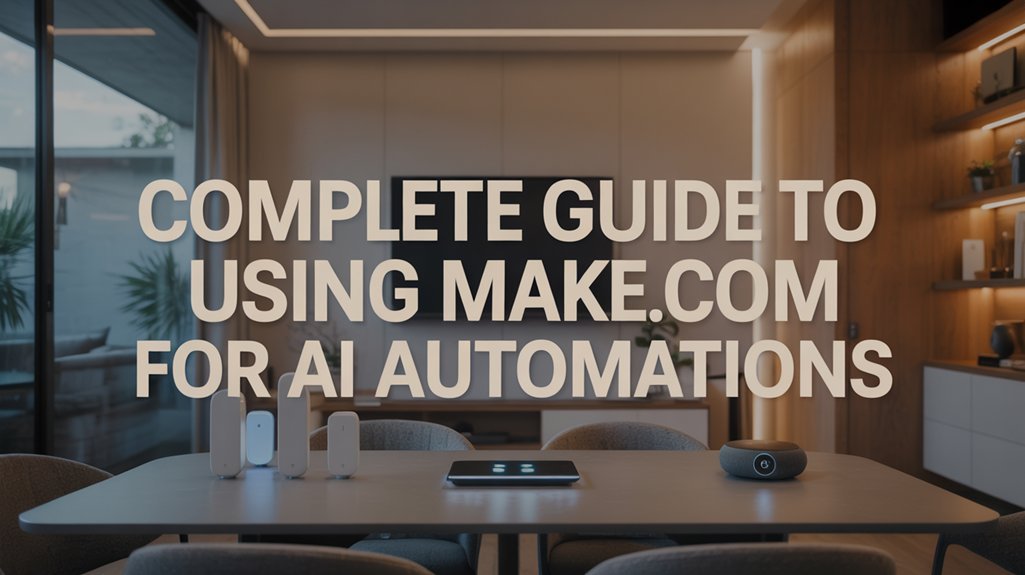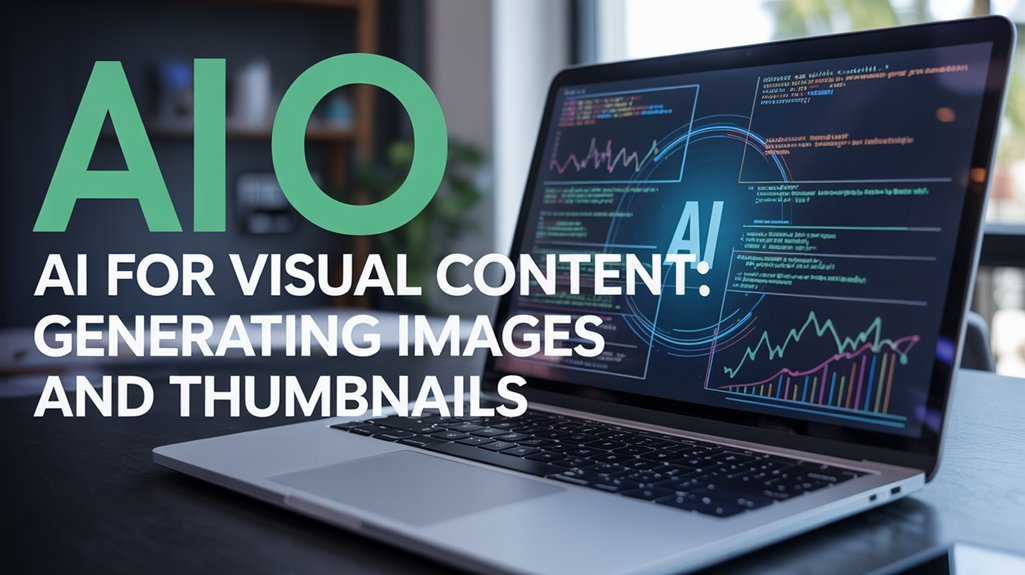AI-powered content creation uses large language models and natural language processing to accelerate your writing process while maintaining quality. You'll eliminate repetitive tasks, improve SEO performance, and scale production capacity by using tools like Jasper, Copy.ai, and Grammarly for text, Midjourney for images, and Kling AI for video. The key is establishing clear content goals, crafting detailed prompts, and implementing rigorous quality controls to preserve your brand voice and credibility. Strategic oversight and multiple revision cycles guarantee your AI-generated content stays authentic while maximizing efficiency—and there's a proven framework to make this change effortless.
Key Takeaways
- AI writing tools accelerate content production by automating repetitive tasks and generating drafts quickly while maintaining quality standards.
- Craft detailed prompts specifying target audience, tone, and goals to guide AI tools toward producing relevant, high-quality content.
- Leverage AI for brainstorming ideas, creating outlines, and optimizing SEO performance through data-driven keyword and readability suggestions.
- Maintain brand consistency by editing AI outputs through multiple revision cycles to match your unique voice and style.
- Fact-check all AI-generated content and implement quality controls to ensure accuracy, credibility, and audience trust.
What Is AI for Content Creation and Why Does It Matter?
Because traditional content creation demands significant time and resources, AI-powered tools have emerged as groundbreaking assets that combine large language models with natural language processing to accelerate every stage of the writing process.
These writing tools enable you to generate ideas instantly, demolish writer's block, and produce high-quality content at scale.
AI modifies your workflow by delivering targeted writing suggestions that maintain your brand voice across every format. You'll simplify the process through automated drafting, headline optimization, and tone refinement—eliminating repetitive tasks that drain your creative energy.
The technology analyzes data patterns to improve SEO performance and readability metrics, giving you competitive advantages in saturated markets.
AI-generated content serves as your strategic foundation, not your replacement. You retain creative control while leveraging machine efficiency to produce more output in less time.
This combination positions you to dominate content channels that matter most to your business objectives. AI-powered writing tools unlock creativity by providing intelligent suggestions that spark new angles and perspectives for your content strategy.
Key Advantages and Capabilities of AI Writing Tools
When you deploy AI writing tools strategically, you'll access three groundbreaking capabilities that reshape your content operations: velocity, precision, and scalability.
These platforms alter your content creation process by eliminating bottlenecks. You'll generate drafts in minutes rather than hours, maintain consistency across all written content, and produce high-quality content at unprecedented volume.
| Traditional Approach | AI-Improved Approach |
|---|---|
| Hours brainstorming ideas | Instant concept generation |
| Manual tone adjustments | Automated style alignment |
| Repetitive formatting tasks | One-click standardization |
| Basic SEO guesswork | Data-driven optimization |
| Limited output capacity | Scalable production |
AI writing tools optimize the entire process through intelligent automation. You'll work more efficiently by delegating first-draft creation while focusing your expertise on strategic refinement. The technology supports SEO practices with keyword integration and readability improvements, ensuring your content dominates search rankings while maintaining your brand's authoritative voice. By leveraging AI insights, you can further enhance your content strategy through data-driven analysis of audience preferences and performance metrics.
How to Effectively Use AI in Your Content Workflow

Understanding AI's capabilities means nothing without proper implementation. Your AI writing partner becomes a competitive advantage when you strategically integrate it into your writing process.
Start by establishing clear content goals that'll guide every decision. Craft detailed prompts that specify your target audience, desired tone, and content objectives—precision here directly impacts output quality.
Here's your implementation framework:
- Initiation phase: Deploy AI for brainstorming ideas and generating thorough outlines before writing.
- Creation phase: Use AI to generate content drafts that accelerate your production timeline.
- Refinement phase: Edit and refine outputs to match your distinctive voice and strategic positioning.
- Enhancement phase: Utilize AI tools to improve your content for SEO and reader engagement.
Your workflow evolves when you help you create systematic processes. AI handles ideation and initial drafts while you focus on strategic direction and quality control.
This division of labor increases output without sacrificing authenticity or impact. Tools like Writesonic demonstrate how AI can unlock creativity and usher in a new era of writing for content creators.
Top AI Tools for Written Content, Images, and Video
Your content strategy demands tools that deliver measurable results across multiple formats. AI writing tools like Grammarly and Jasper revolutionize how you create quality content, offering real-time suggestions for clarity while helping you automate repetitive writing tasks.
These writing assistants integrate effortlessly into your workflow, generating everything from social media posts to extensive marketing copy.
For visual dominance, Midjourney produces photorealistic images that captivate your audience, while Kling AI delivers social media-ready videos for both beginners and advanced creators.
SEOWind sharpens your competitive edge by generating SEO content briefs from primary search terms, ensuring your content ranks.
Copy.ai and similar platforms provide customizable workflows that let you scale production without sacrificing quality.
Generative AI can help you maintain consistency across channels while producing engaging content that converts.
The right combination of these tools positions you to dominate your market through superior content execution. To maximize your results, explore AI tools and productivity guides that help you implement these technologies effectively.
Challenges and Best Practices for AI-Assisted Writing

While AI tools accelerate content production, they introduce critical challenges that'll undermine your results if left unaddressed.
AI-assisted writing demands strategic oversight. Generic outputs erode your competitive edge, while inaccurate information destroys credibility. You must implement rigorous quality controls to maintain authority.
Without strategic oversight and rigorous quality controls, AI-generated content will erode your competitive edge and destroy hard-earned credibility.
Master these effective strategies:
- Verify relentlessly: Fact-check every AI-generated claim before publishing; outdated or false content damages your reputation irreparably.
- Refine through iteration: Alter generic drafts into strategic assets through multiple revision cycles that improve clarity and engagement.
- Maintain transparency: Disclose AI tool usage to address ethical considerations and preserve audience trust.
- Balance automation with creativity: Inject your unique perspective to differentiate your content from competitors' AI-generated material.
Precision in prompts determines output quality. Vague instructions yield worthless results.
Your competitive advantage lies in treating AI tools as enhancers of expertise, not replacements. Commit to continuous refinement, prioritize authenticity, and utilize AI-assisted writing as a force multiplier for strategic content dominance.
Frequently Asked Questions
How to Use AI to Make Your Writing Better?
You'll boost your writing by deploying AI tools for thorough writing assistance—from idea generation to content optimization.
Utilize grammar checking and style improvement features to eliminate errors while maintaining authority. Use tone adjustment to match your audience targeting strategy, and integrate SEO optimization for maximum reach.
AI-powered research automation delivers data-driven insights instantly, letting you focus on strategic messaging.
You'll dominate your content space by combining these capabilities to produce precise, powerful writing that converts and commands attention.
How Can You Make AI Write More Compelling Content?
Want to dominate your market? Command AI to craft compelling content by mastering persuasive techniques through precise prompts that specify audience analysis and emotional appeal.
Integrate storytelling elements while maintaining your unique voice. Structure content strategically with keyword optimization and engaging headlines that convert.
Utilize visual integration to amplify impact. Apply rigorous editing strategies to refine output.
You'll change generic AI drafts into authoritative content that drives results and establishes your competitive advantage in any marketplace.
How to Improve Ai-Generated Content?
You'll enhance AI content through strategic quality assurance: employ editing tools for tone adjustment and contextual relevance, then implement rigorous fact-checking methods.
Refine with SEO-driven personalization techniques that increase audience engagement. You're establishing dominance when you balance ethical considerations with data-driven refinements.
Don't settle for generic output—command superior results by systematically auditing every element. Your competitive edge depends on converting raw AI content into authoritative, targeted assets that convert.
Master these protocols, and you'll control the content landscape.
Is Chatgpt the Best AI for Writing?
ChatGPT isn't definitively the “best”—your comparison analysis must consider specific needs.
While its ChatGPT features excel at writing efficiency and user experience, AI limitations in content originality and creative writing demand scrutiny.
You'll find competing language models offer different strengths for various tasks.
Consider AI ethics, future developments, and your strategic objectives when selecting tools.
Don't rely on brand reputation alone—evaluate performance data against your content goals to make power-driven decisions that enhance your competitive advantage.
Conclusion
You've explored how AI alters content creation—from accelerating workflows to revealing new creative possibilities. But remember: AI is your collaborator, not your replacement. The most effective content strategy combines AI's efficiency with your unique expertise and audience insights. Start with one tool that addresses your biggest bottleneck, measure the results, and iterate. Ready to reclaim 40% of your content production time? Your competitive advantage lies in implementation, not hesitation.








